Enterprise Level VoIP Solutions & Applications
The idea of conducting all your telephone calls over the public Internet and avoiding high long distance charges from the Telco in the process is an attractive one for any budget-conscious CIO. However, voice quality and reliability have been big issues for the most VoIP services, adding to the different kind of VoIP vendors in the market, kept many organizations’ CIOs a little confuse in discovering the best VoIP products or solutions which best suites the organization’s requirements.
The compelling factor behind the implementation of VoIP is a practical one: cost. Long distance charges can cost businesses thousands of ringgit every month. If the business has a fixed cost, with unlimited access connection to the internet, calls transmitted over that connection can be effectively free. But, why many business CIOs still feel hesitant and uncertain to abandon the public telephone network and make calls over IP?
While the IP hardware vendors and IP system integrators are trying to move closer to true interoperability of any IP platform, VoIP service providers are largely moving in the opposite direction, disintegration the potentials of IP solutions into fragments. These IP service providers are giving very attractive packages to the corporate organizations even at the cost of zero initial investment. This invites CIOs to jump into the VoIP bandwagon without identifying their organizations’ needs and requirements on VoIP solutions, but later found out that what they had deployed does not meet their organizations’ requirements and lead to a dubious view on future VoIP deployments.
Any true IP vendor who is familiar with voice and data integration with IP platform will definitely assist the SME, SMI and the corporate organizations to see the whole picture of IP potentialities instead of just having cheaper call rates. These true IP vendors will emphasis on reliability, security, voice quality, interoperability, integration with the current work flow, transparency, ease of use, expandability and all these can be deployed at a very affordable price.
The factors which any organization’s CIO should look into are:
Initial setup cost – Although there are low cost and even free means to transmit voice over IP, an enterprise level organization that is serious about VoIP will have to invest on a more reliable and quality VoIP products that meet the enterprise level requirements.
Voice quality and reliability issues – It is always a waste of time, money and man-power to test and purchase gateway products which do not produce telco grade voice quality. A product which is not reliable and flexible will definitely jeopardize the organization work-flow especially during critical moments.
Security issues – CIOs who are implementing the VoIP solutions in a bid to cut communications costs should not overlook the security risks that can crop up when the VoIP users are getting larger. Most CIOs are more concerned about the voice quality, the delay and the latency, that they have overlooked the dangers of unsecured VoIP services. In fact, the voice packets should be encrypted and run it over a VPN (Virtual Private Network).
Incompatibility issues – Some services require that both the caller and the called party be subscribers to their service, where there are some software programs to be installed at both parties’ computers, in order to conduct VoIP. However, there are also some other services allow you to call anyone, including calling to a regular phone at a certain fix cost per month. But then again, are all these compatible with the current organization workflow?
Any wise CIO will definitely evaluate the employees’ telephony needs and will always run a pilot program first, testing VoIP with a small group of users, before rolling out a VoIP solution to the entire organization. In most organizations, normally the ratio of phone calls from the employees compared to the middle and top management will be at 80:20. The employees are the ones that call the most often in order to conduct their work. Therefore, it will be no point for any organization to just deploy the VoIP applications for the top management only, but a wiser choice to have the deployment to benefits all parties in the organization.
Different kinds of VoIP applications serve different nature of business. CIOs of any organization need to identify their organization’s needs and requirements on VoIP solutions, before jumping onto the band wagon. Always ask, can we invest on RM 30,000 and later found out that it would not work, and then invest another RM 50,000 for better and more reliable equipment?
The Potentials of IP Applications and Solutions
The below diagrams shown are the potentials of IP applications and solutions that can be provided with the availability of internet broadband or any managed IP network. These diagrams are actually real models and running real time at our corporate customers’ premises.
Free Inter-branch Calls and Faxes. (Voice over IP and Fax over IP)
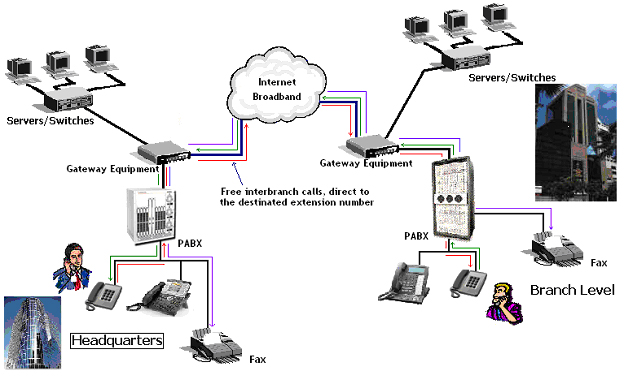
The above diagram shows ‘free’ inter-branch calls and faxes between the Headquarters and the branch level. The calls are very transparent, as all calls are dial directly to the destinated extension numbers without going through the operator/receptionist. No speed dial is necessary as only extensions numbers between the sites are dialed. In other words, it is a virtual private network for voice and faxes over the internet broadband or any IP network.
Security through a Virtual Private Network(VPN)
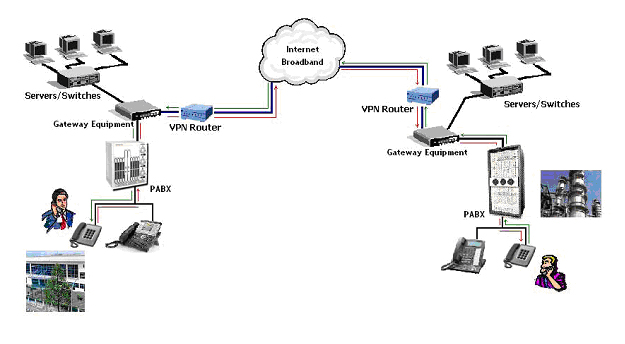
Virtual Private Network (VPN) is similar to a wide area network (WAN) with a securely encrypted tunnel, authentication and access control technologies, but it is able to use public networks like the internet rather than expensive, private leased lines.
Any voice packets without encryption that are floating in the internet cloud will be put into risk. The above diagram shows that all voice packets going into the internet cloud are encrypted through the VPN tunnel by deploying a VPN router.
Outbound Calls (Hop On Calls)
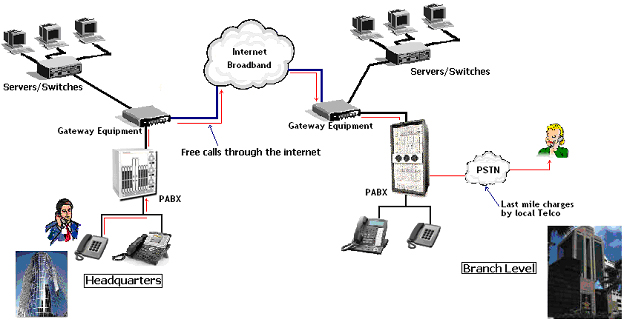
Staffs at Headquarters could seize the branches PSTN line to call out and just being charges at the branch’s regional local charge by the local Telco.
For example, if staffs at Headquarters located at Kuala Lumpur call to customers in Penang, they can use the VoIP call to Penang’s PABX which is free and then seize a Penang branch’s PSTN line to call to the Penang customers. Hence, the charges will be only RM 0.04 per minute which is the local telco rate.
Another example, if staffs at Headquarters located at Kuala Lumpur call to customers in Hong Kong, they can use the VoIP call to Hong Kong’s gateway and then seize a Hong Kong branch’s local PSTN line to call to the regional customers. Since the Hong Kong local call rate is free, hence the all calls to Hong Kong customers are free.
IP Based Centralize Contact Centre
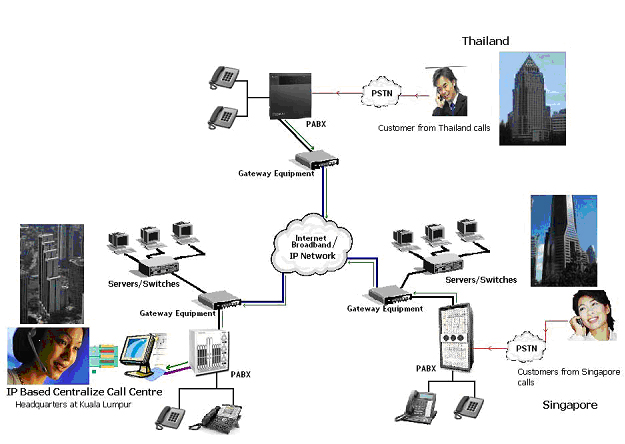
The contact centre/call centre is located at Kuala Lumpur. The customers call from Thailand and Singapore can be routed back through the internet broadband to the contact centre at Kuala Lumpur. The calls can then be transferred back to the respective branches through the internet if necessary. Therefore, customers will not be asked to dial another number to get to the person he/she wants to speak to. For security purposes, all the voice calls can ride on the VPN network.
Voice over IP Calls Routing through the Internet Broadband
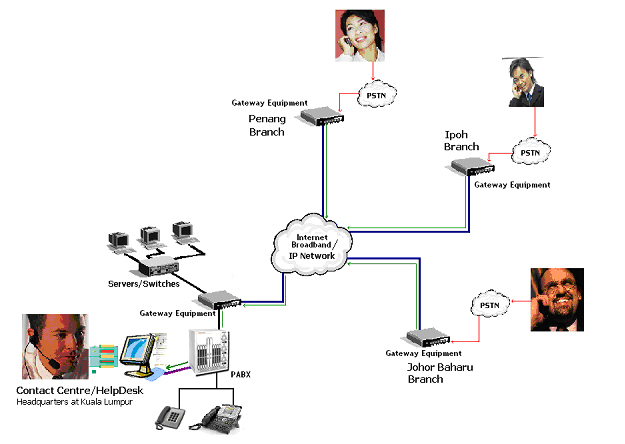
There is no physical operational office at the branches to answer calls from customers. The organization can save on employing receptionist at the branches (or relocate them for other purposes) because all calls are routed back through the internet broadband to be answered by the Helpdesk agents at Kuala Lumpur.
Fax Routing through the Internet Broadband
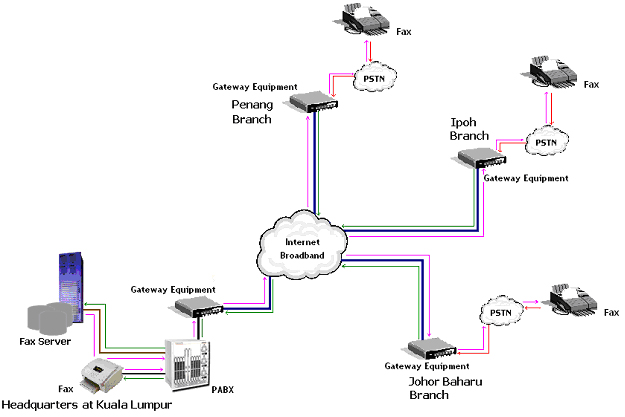
This is similar with the voice call routing. Incoming fax can also be routed through the internet broadband to the centralize fax or fax server at the organization’s Headquarters. At Headquarters, faxing out to the respective branches’ customers is also applicable by utilizing the gateways at the branch level to seize the local PSTN line to fax out.
Voice over IP though Internet Broadband for Remote Employees

Remote employees can dial back to the office extensions from the remote site with the availability of Wifi or any Internet Access Point. The remote employees can use any SIP phones or SIP softphones. Similarly, the office employees can also call the remote workers by just dialing the SIP softphone extension number.
The remote workers can also seize the office’s PSTN line remotely, and then call to the outside customers by using the office’s PSTN line. Similarly, customers call from outside can also transferred to the remote workers via the internet broadband.
Work At Home
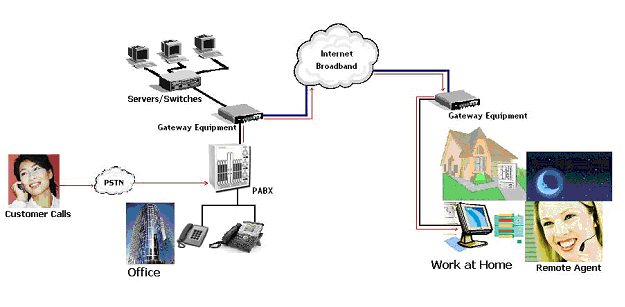
Customers’ satisfaction is a very important to gain customers’ loyalty, especially to organizations that emphasis more on service sales. This is an added on services for organizations who want their customers to be reached even after office hours.
Therefore, the calls from customers after office hours can be routed back to any home based remote agent. Organizations do not need to employ workers to be located at the office where overhead cost will be higher.
VoIP Calls from Offshore (Or any Remote Area)
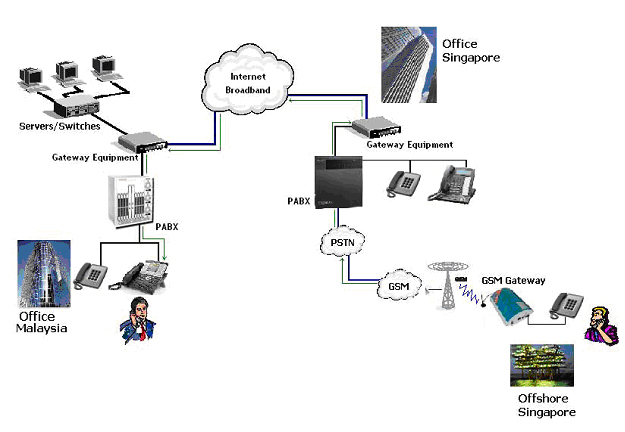
Since there is no phone line at Offshore office, staffs at the Offshore office could call back to the Malaysia office through the GSM network and seize the gateway in Singapore to dial back to the Malaysia gateway via internet broadband.
Voice over IP through VSAT (Very Small Aperture Terminal)

VSAT is an earthbound station used in satellite communications of data, voice and video signals. VSAT service is applicable to sites that are not able to be reached by any physical cable for the means of any IP network. Normally, bandwidth given by VSAT will be very small, as low as only 32kbps.
A true IP based application can even be carefully deployed using the means of VSAT, where the bandwidth given and the satellite latency are very critical issues.
Voice over IP through 3G Network
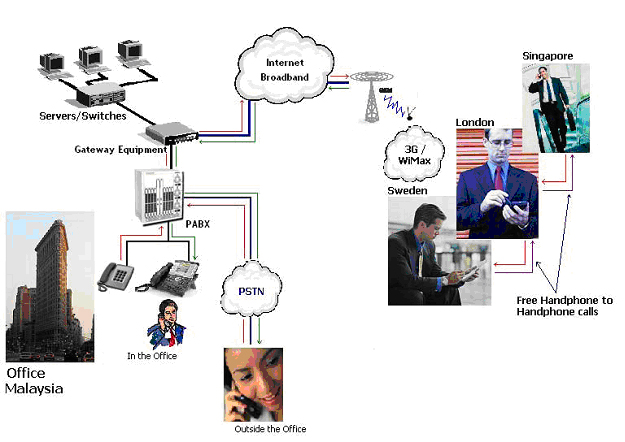
Voice over IP through 3G network can be made possible with the availability of 3G network coverage and handphones that can support 3G (with windows operating system or any operating system that can support SIP client).
This IP application allows staffs in the office to call to any remote staffs under the 3G coverage area. Incoming calls to the office can also be transfer to these 3G handphones. These remote staffs can also us the 3G handphones to call to any customers using the office line via 3G. All the organization’s staffs (under same grouping) can call each other for free with these handphones via 3G network.
Integrated IP Applications and Solutions
The below diagram show the entire picture of an enterprise integrated IP applications and solutions.

The below diagram show the entire picture of an enterprise integrated IP applications and solutions.
